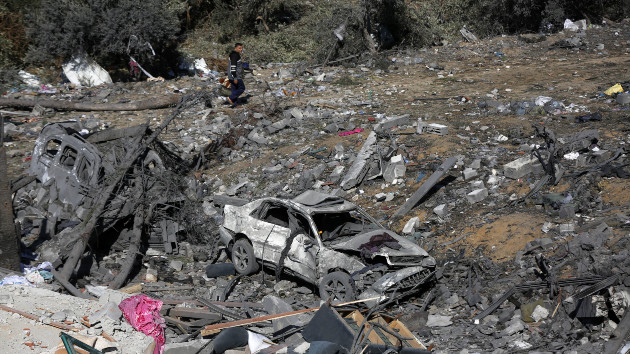(TEL AVIV, Israel) — Two United States-based researchers analyzing the destruction of northern Gaza using radar waves and satellite imagery from space have compared the widespread damage to the decimated cities of Mariupol in Ukraine and Aleppo in Syria during wartime.
Following Hamas’ unprecedented surprise attack in Israel on Oct. 7 that Israeli officials say has killed more than 1,200 people, Israel responded with a retaliatory bombing campaign of the neighboring Gaza Strip.
The closest comparisons the researchers, Jamon Van Den Hoek from Oregon State University and Corey Scher at the CUNY Graduate Center in New York, could make to what has happened in Gaza to other conflicts were the city of Mariupol, decimated by Russia after its invasion of Ukraine in February 2022, and Aleppo, the city reduced to rubble by government forces during the Syrian civil war.
“The only other analogs that I think we’ve looked at in terms of the extent … the broad extent of damage, those are the first two cities that come to mind for me,” Scher said. “Aleppo and Mariupol.”
In the wake of the Israel-Hamas war, the view of Gaza from space, according to Van Den Hoek and Scher, shows widespread damage. Between 40% and 51% of all buildings in northern Gaza have been structurally damaged since Israel declared war on Hamas, the researchers said.
Scher told ABC News that their team uses radar to determine any changes in the structures of buildings in Gaza. Because there has been no construction, the only changes to the buildings are as a result of damage, he said.
“If you go into a room and you speak, there’s no furniture or rugs or anything in the room and you hear an echo,” Scher told ABC News when asked how to explain how their research using radar has been conducted. “You remember that echo, and you go back in the room after placing a rug or a bookshelf with books on it. Speak again. Listen. Remembering your old echo, you … can detect a change. We’re looking for similar changes in the echoes of radar waves.”
Applying that method using radar signals from the European Space Agency’s Sentinel-1 satellite, the researchers said they were able to detect the number of buildings damaged, but were not able to determine how badly the buildings had been affected. Scher and Van Den Hoek say they have worked extensively using those techniques to chart structural damage in the Syrian civil war, Ukraine war and previous Gaza conflicts.
“The scale and the speed of damage in this war is pretty unprecedented in our work on looking at Gaza,” Van Den Hoek said. “We have been expecting for a long time with the shift in the military strategy [of] the IDF [Israel Defense Forces] to start doing more ground-based assaults, less aerial bombardment. Every week we see this growth of damage and we see areas that have been previously hit. We see them being hit over and over and over at the core of the city first and the periphery.”
Van Den Hoek and Scher, who are urban geographers, said the Israel-Hamas war differs from the Ukrainian and the Syrian civil wars because only a “trickle” of Gazans have been able to flee.
Gazans have endured devastating strikes from the air, with the IDF laying waste to large swaths in Gaza, a 140-square-mile strip of land along the Mediterranean Sea surrounded by Israel and Egypt. The IDF claims to have hit hundreds of Hamas targets since the war began.
The IDF has said it established control of northern Gaza as it continues to battle Hamas terrorists, who the IDF says have a widespread underground tunnel system designed to conceal and cover militants and execute attacks. Above ground, journalists have been offered a glimpse into the destruction in northern Gaza during media visits organized by the IDF.
As the first week of the Isarel-Hamas war came to an end, Israel began warning more than one million Palestinians to move to a safer part of the territory, in southern Gaza, as Israeli soldiers prepared what was expected to be a massive ground campaign. In the weeks that followed, thousands of people sought refuge at Egypt’s Rafah crossing as Israeli retaliatory airstrikes pummeled Gaza, intensifying the humanitarian crisis there. The crossing eventually reopened and some people were able to leave.
“What is so distinct about Gaza, though, [from] anywhere else in the world is that it is such a compact living environment and it is containerized,” Van Den Hoek said. “We’re mapping something that doesn’t move — buildings and the damage — but where people are in this really complex landscape of unpredictable rocket fire, unpredictable attacks, unpredictable aid, electricity, water … it’s really a dire situation.”
The Hamas-run Gaza Health Ministry says at least 14,128 people have been killed in Gaza amid Israel’s retaliatory campaign and effort to root out Hamas. More than 33,000 have been injured, the ministry says, with almost 1.5 million people displaced, according to the United Nations Relief and Works Agency.
Copyright © 2023, ABC Audio. All rights reserved.












